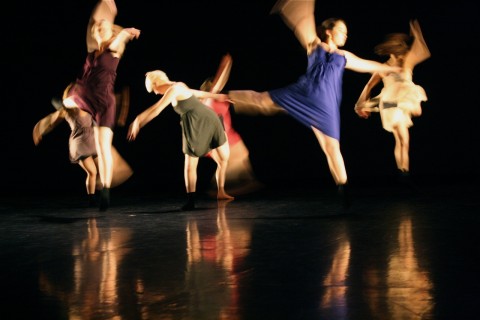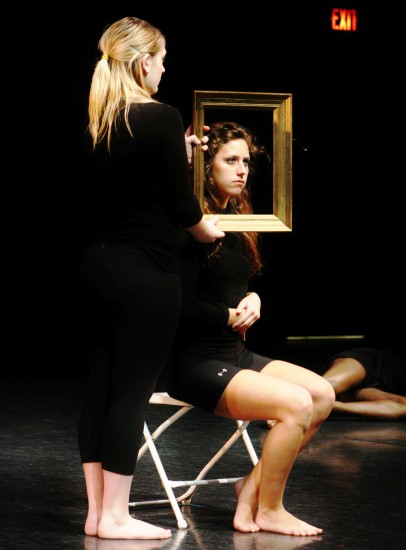
Photo by Cecelia Brown
Myers Dance Studio echoed with stifled coughs. The faces of my peers were menacing, each smile concealing colonies of scheming pathogens, trying to hop from one weak immune system to another. I took my seat, bristling every time my neighbor emitted a sniffle or a nasal muttering. When I am sick, I am oppressively aware of my body: its struggle to perform normal functions like eating, breathing, and thinking, its heaviness as I heave it across campus and its yearning for quilts and chicken broth. As the lights dimmed and the Dance Club show began, I wanted to be distracted by the girl on stage making faces through a picture frame. The dancers stood tall like healthy plants growing towards the sun. I, on the other hand, was in the shade of the audience, the bacterial breeding ground whose flu-spreading agents would eventually destroy me like a fungus that makes stalks shrug and leaves wilt.
The dancer who had been making faces joined the other girls on stage in hand-mouthing the words to some of Shakespeare’s sonnets. The piece, entitled “This is Art” and choreographed by Chloe Spitanly, was as beautiful as it was bewildering. After Shakespeare was silenced, Tchaikovsky’s “Little Swans” took over the stage and the dancers launched into some brilliant booty shaking.
Wayne Ong’s piece, “A Bitter Swallow”, was gorgeous and fluid in its subtlety, even to a naïve eye like mine. Freshman Shanna Polzin danced it with effortless grace that would have driven Nina Sayers into a jealous nervous breakdown.
The following pieces, by Jillian Wiseman, Ayano Elson, and Kadie Greenfield, respectively, were similarly lovely. Each movement followed the next like neatly chosen adjectives stacked before a noun, the sounds of the dancers’ feet, arms, and legs hitting the floor like punctuation. Wiseman’s piece was inspired by and named for the Dave Mathew’s Band song, “Gravedigger.” The movements made grave digging, an activity usually reserved for radio horror serials or Cohen Brothers films, look refreshingly graceful. Elson’s “This Vehicle Has Been Checked For Sleeping Children” did not include any of the implied cars or children but it was no less visually arresting; the difficulty in finding an obvious interpretation of the movements lent the piece a bit of mystery. Greenfield’s “12° 30’ 0” N, 69° 58’ 0” W” incorporated piles of sand on stage as a nod to childhood memories. The piece was languid and full of calm. Each of these pieces showcased the dancers’ faculty with dance as a language, to write it through choreography and to speak it through movement.
My attention waxed and waned, shifting from watching pieces onstage to estimating the germ risk level of leafing through my neighbor’s heavily handled, program. I began to feel painfully un-dancerly. The next piece, Gabi Goszczynska’s “Five to Nine,” performed to the hip-swing-inducing beats of Robyn, contained as much exuberance as Gabi’s surname contains adjacent consonants. I was suddenly jealous of these free individuals who are unafraid to roll around on the floor in front of a bunch of strangers. But the thought of joining the dancers in their wild gesticulating didn’t just make me nauseous, it made me scared. Onstage I would feel my posture, slumped, and my arms, splayed awkwardly, and my face, contorted by a combination of bewilderment and concentration. I felt like the antithesis of a dancer: the bad kind of self-aware.
As if reading my self-conscious mind, Candace Taylor took the stage next to introduce her piece, “How Narcissism Saved Me.” The piece was the only one performed to live music, by Liz De Lise on acoustic guitar. With a mixture of spoken word and dance, Taylor and accompanying dancers Skyler Volpe and Rachel Pritzlaff sent a powerful message about a journey towards self-acceptance and the importance of loving oneself. These ideas were carried into the next piece, Matty Burns’ “Some for you and some for me.” His piece was surprising, touching, enthralling, and even a little bit of a tease, though the piece’s charm lay in its beautiful and interesting choreography, not its shock value.
The last two pieces were a welcome decompression after the introspection prompted by Burns and Taylor. Liz Charky’s “on feeling for sound or something” was as aesthetically seamless as it was distinctive and playful; the highlight was a human totem pole of silly faces. The finale was Skyler Volpe’s wonderfully disorienting “And then, the most magical thing happened…,” a kind of Disney-muscial-esque fever dream of leaping, grimacing, and screaming dancers.
After the show ended and we shuffled out of the studio, I paused to congratulate one of the dancers on a job well done.
“You were amazing!” I said.
“Tha—” she began, but her face contorted like a crumpled napkin. “Thaa—” she began again. Even from this small fragment of a word I recognized congestion’s dirty fingerprints all over her voice. It was too late to dodge the impending attack and nowhere to run in the crowded room. I could almost see the germs, projected on a spray of spit, hurtling towards their new host. I put up a brave fight but I should have known it was a losing battle.
“ACHOO!” •

Photo by Miguel Salcedo








